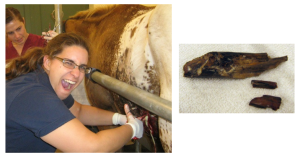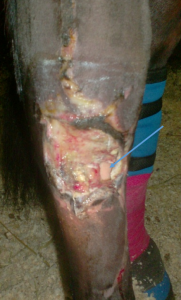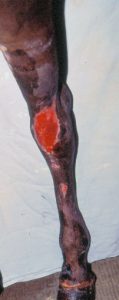Large animal wounds
Non healing wounds
Similar to abscesses, nonhealing wounds typically involve an underlying issue. These tend to appear in two different forms.
Incomplete granulation
If granulation tissue is not covering the wound and/or drainage is noted:
- foreign body – remnant from the original trauma or suture material from the repair

- lack of ventral drainage – a pocket or tract that is being forced to drain upwards
- sequestrum – fragment of bone serving as a foreign body
- damaged or decaying tissue – tendon fragments, etc
- flow of fluid (milk, synovial fluid, urine) – fluid flow acts to keep the pathway open

Evaluation includes ultrasonographical examination, wound probes and surgical exploration.
For most, treatment involves removing the foreign body and/or creating ventral drainage. En bloc resection of the entire tract may be performed if drainage is persistent but a source cannot be identified.
Incomplete epithelialization
If the granulation bed is complete but epithelialization has stalled, consider:
- motion – especially wounds over joints
- continued trauma
- biofilm development
- a combination of these factors

If the limb wound has covered in granulation tissue but not skin, skin grafting is recommended. If the area is repeatedly traumatized, bandaging may be required (with concomitant proud flesh management).
A biofilm is an organized bacterial community that creates a layer of “slime” over the wound surface. This biofilm is resistant to most therapies and is treated with debridement, topical treatment (antibiotics, antiseptics) to delay reformation, and repeated therapy until resolved. See the excellent review by K Marchant et al. This includes debridement and topical therapy reviews as well as a deeper coverage of biofilms.
Resources
Marchant K et al. Review of the role of biofilms in equine wounds: Clinical indications and treatment strategies. Equine Vet Educ. 2024;36:152–168.
pieces of dead bone that cause persistent draining tracts as the body tries to liquefy them
exuberant granulation tissue

